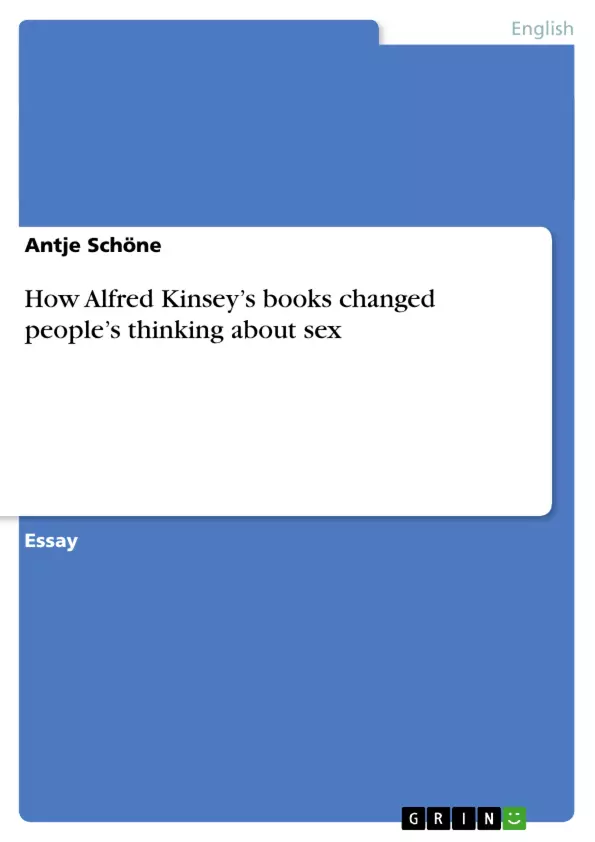Short essay of 5 pages on some biographical dates of American biologist Alfred Kinsey and how he came to work with sexual behavior. It also shortly looks at the culture of America at this time and how his books changed people's thinking about sex.
TU Dresden SS 05
Antje Schöne
Tutorial of American Culture Studies
1 August 2005
How Alfred Kinsey’s Books Changed People’s Thinking About Sex
After having watched the film ‘Kinsey’ in the movie theater, I was surprised that people in America had so little knowledge about sex just 60 years ago. After Kinsey had been asked in the film when he masturbated the first time, he remembers a situation in a Boy Scout camp. He and his friend were talking about wet dreams and looked it up in their book. It said that every need to masturbate should be counteracted. Doctors estimate that it can cause brain disease, blindness, epilepsy and even death. What you can do to counteract is to read the Bible, think of the pure love of your mother or to put your penis in cold water.[1] I could not believe that people were holding on these ‘facts’ and even teach them to others. This made me interested in what the situation was like in the 1920s to 1960s and how Alfred Kinsey’s books changed the nations mind.
Alfred Charles Kinsey was born in 1894 in Hoboken, New Jersey. After his graduation from Bowdoin College, he became an instructor in biology and zoology at Harvard University. Later he joined the zoology Department of Indiana University and became the world’s greatest expert on the gall wasp.[2] “The institute had its beginnings in 1938 when Indiana University responded to women students' request for a marriage course and asked Alfred Kinsey, a professor of biology, to develop a class that would educate women students and their husbands and fiancés about sex.”[3] The Institute for Sex Research, Inc. was officially founded in 1942, supported jointly by Indiana University, the Rockefeller Foundation, and the National Research Council. Kinsey died on August 25, 1956 in Bloomington, Indiana.[4]
When Kinsey was young he stood under strict and stern education from his father Alfred Seguine Kinsey. He forbade any contact to girls and did not talk with his children about masturbation, nocturnal emission or intercourse, except saying that it is sinful and forbidden. And that is exactly how the situation was like at the beginning of the 20th century in the whole United States. The hysteria about masturbation in this period is well known, 40 % of the boys 1939 thought that masturbation causes insanity. People also believed in the saying that “God had given young man at around puberty a vital substance which turns boys into men. The effect of wasting this vital fluid could be very dangerous indeed.”[5] Only the fact that they call it ‘vital fluid’ and not seminal fluid really is conservative and inhibited. Before the late 1940s, the sexual lives of most people were shaped by personal experiments, isolated sexual encounters, uninformed gossip, media sensation, and moral condemnation - not necessarily in that order. The national myth was that most people were obedient to a traditional set of sexual rules and those who were not were relatively rare and defective in morals or willpower. This shows the “confused, silenced, frightened, ignorant, repressive, puritan-dominated attitudes”[6] back then.
[...]
[1] Kinsey. Direction and screenplay by Bill Condon. Perf. Liam Neeson, Laura Linney, and Peter Sarsgaard. USA, 2004.
[2] Halsey, William D. Kinsey, Alfred Charles. Ed. Collier’s Encyclopedia. Vol. 11 of 24. USA: Crowell- Collier Educational Corporation, 1969. p. 100
[3] Moke, Susan Learning from the Past - Looking to the Future. Research and Creative Activity, September, 1997. < http://www.indiana.edu/%7Ercapub/v20n2/p6.html>
[4] Halsey, William D. Kinsey, Alfred Charles. Ed. Collier’s Encyclopedia. 1969. p. 100
[5] Gathorne-Hardy, Jonathan. Sex the Measure of All Things. London: Chatto & Windus, 1998. p. 21 - 22
Frequently asked questions
What is the document about?
The document is an academic paper likely used for a tutorial or study in American Culture Studies, specifically focusing on how Alfred Kinsey's books impacted people's understanding and views on sex.
Who was Alfred Kinsey?
Alfred Charles Kinsey was a biologist and zoologist, born in 1894. He became a professor at Indiana University and an expert on the gall wasp. He is best known for his research and publications on human sexuality.
What was the Institute for Sex Research?
The Institute for Sex Research, Inc. (now known as The Kinsey Institute) was founded in 1942. It was supported by Indiana University, the Rockefeller Foundation, and the National Research Council. It originated from a request by female students for a marriage course.
What was the prevailing attitude towards sex before Kinsey's research?
Before the late 1940s, the attitude towards sex was largely shaped by personal experiences, gossip, and moral condemnations. There was a widespread belief that people should adhere to traditional sexual rules, and deviations were considered immoral or indicative of a lack of willpower. Ideas about masturbation were particularly negative and often associated with health problems.
What were some of the myths surrounding masturbation during that time?
There were common myths that masturbation could cause insanity, blindness, epilepsy, and even death. The prevailing belief was that young men possessed a "vital substance" that should not be wasted, as doing so could have dangerous consequences.
Where does the author gain inspiration from?
The author gains inspiration to write about Alfred Kinsey from a film.
What sources were cited by the author?
The author cited "Kinsey" (the film), Collier's Encyclopedia, a research article from Indiana University titled "Learning from the Past - Looking to the Future", and "Sex the Measure of All Things".
- Quote paper
- Antje Schöne (Author), 2005, How Alfred Kinsey’s books changed people’s thinking about sex, Munich, GRIN Verlag, https://www.grin.com/document/111712



